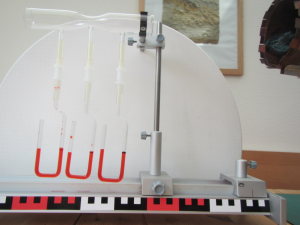
Playing with Venturi tubes
A Venturi tube is one of the things one hears about in hydrodynamics class all the time, but one never gets to see them for real. And even though I just said on Friday that the thing that I found most fascinating in the aerodynamics collection I got to borrow recently was to see how the flow reversed downstream of a paddle I might have to take that back, because the hands-down most exciting thing was to play with a Venturi tube!
So what is all the fuss about? This is what a Venturi tube looks like:
Basically, it is a tube, open at both ends, that gets thinner in the middle and wider again. All the rest you see in the picture is props: The mouth of the fan in the top right, and then three U-tubes filled with dyed water below the Venturi tube.
The Venturi tube is so famous because it nicely demonstrates the Venturi effect, namely the reduction in pressure that occurs when a flow is accelerated. In the case of the Venturi tube, the flow is accelerated in the thin section of the tube, where – for continuity reasons – it has to go faster than in the wider sections. So what happens when we turn on the fan?

Venturi tube. Pressure decreases in the thin section of the tube, visible by the red water being “sucked up” in the middle U-tube
Yep! The levels in the three U-tubes change. And most importantly, the pressure for the middle U-tube drops, as demonstrated by the red water being “sucked up” on the side of the U-tube that is connected to the Venturi tube.
Watch the movie below to see this in action:

Sand ripples. Why do they form in the exact way they do? - Adventures in Oceanography and Teaching says:
[…] becomes) and slowing it down when the cross section widens again (see here for the classical fluid dynamics Venturi tube experiment that shows exactly that). So a current flowing over a bump will be sped up. Looking closely at the […]
Why the Isère reminds me of a water jet pump | Mirjam S. Glessmer says:
[…] be brought upstream in order to get sucked into the jet. That’s also similar to playing with Venturi tubes where the thinner the tube, the faster the flow, the lower the pressure… Anyway, riddle […]
Playing with Venturi tubes II | says:
[…] ← Previous […]